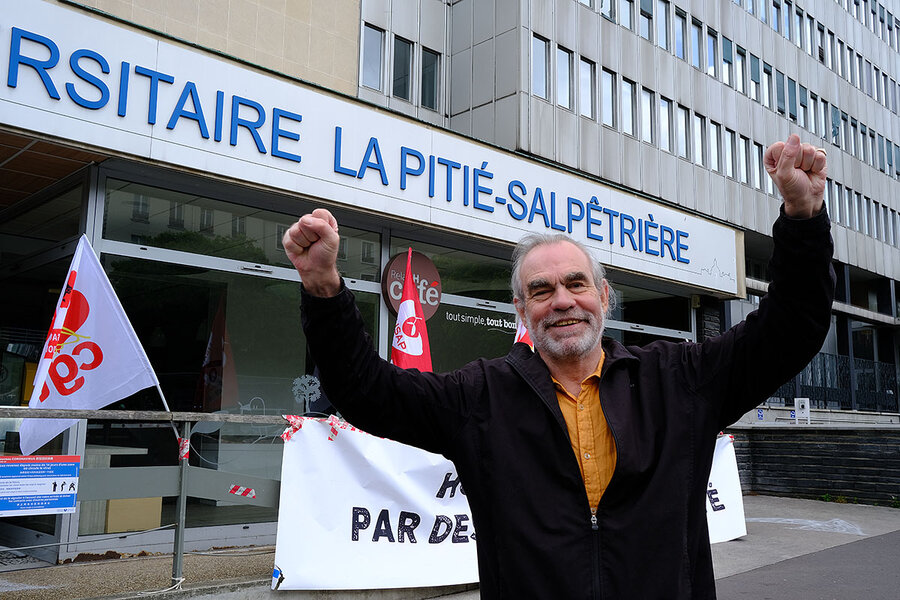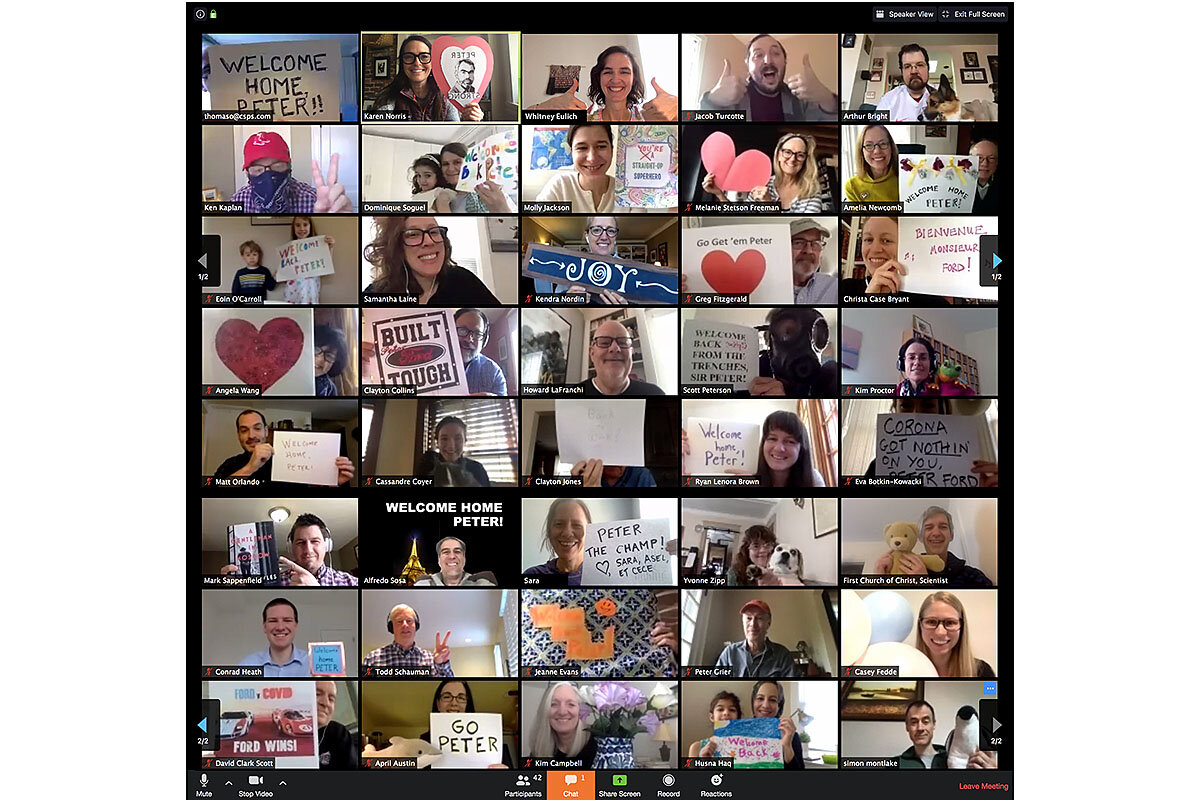‘Left with my thoughts’: How our reporter fought the coronavirus
| Paris
As far as I was concerned, once I had finished my lung scan at the clinic I was going back home, and I told the ambulance driver as much.
He scoffed. A little lacking in bedside manner, he told me bluntly that “the only place I’ve ever taken someone with a blood oxygen level as low as yours is the emergency room.”
He was right. The clinic sent me straight to hospital. And so began my personal fight with the coronavirus that has struck at least 3 million other people around the world.
Why We Wrote This
Brave health care workers, strong family bonds, a flood of support and prayer from friends around the world: Our correspondent, Peter Ford, shares how all helped him heal.
Obviously, I lived to tell the tale. And so have almost all the other 3 million victims. In France, where I live, the overwhelming majority of even the worst-affected patients survive. Some 83,000 people were hospitalized with coronavirus here during the first seven weeks of the pandemic; it is worth remembering that 84% of us were healed.
The hasty transfer to a hospital near my Paris home was not in fact the start of my coronavirus experience. I had already been confined to bed at home for 10 days, cared for by my wife and two adult sons.
But now I was getting short of breath. As my wife, Edith, blew me a goodbye kiss from the entrance to the blue canvas tent that served as the hospital’s makeshift admissions area for coronavirus cases, I felt extremely vulnerable.
A hospital emergency room in high gear, however, does not leave you much time to feel lonely. I was prodded and probed, quizzed and queried, measured and metered. And then wheelchaired to a little electric van that whizzed me to the building set aside for coronavirus patients.
A new set of rhythms
I was at the Pitié Salpêtrière hospital. More than 400 years old and spreading over several city blocks, the “Salpet” – as the place is known to Parisians – is one of the top teaching hospitals in Europe. Its staff had all the personal protective equipment they needed, unlike a suburban hospital where a doctor friend was working, using a plastic trash bag as a gown.
I found myself in a tall-windowed single room flooded with light, which made me more fortunate than most of my 100 fellow coronavirus patients. I was in total quarantine in the soundproofed room, but my mobile phone brought the world to me: I talked several times a day to my family, I got calls and messages from around the world, I listened to the BBC and French news, I streamed Schubert and Vivaldi and Aretha Franklin.
A nurse showed me how to fasten the two little tubes that fed oxygen into my nostrils and soon I was sucked into the implacable rhythm of high-maintenance hospital life, with visits from doctors and nurses and catering staff and cleaners – all covered head to toe in disposable protective gear – from six in the morning until 11 at night.
Every one of those doctors and nurses and kitchen staff and cleaners, a nurse told me, had volunteered to serve on the coronavirus ward. No one who did not want to work there was obliged to do so. That, perhaps, explains why all the staff treating me were so young; all the doctors who cared for me were interns in their 20s. Their courage, and that of their nursing colleagues, was intensely moving.
Less impressive, unfortunately, was the catering. Like many severe coronavirus patients, I had lost my senses of taste and smell, and with them my appetite. I faced difficulty forcing down a few spoonfuls of yogurt; even a banana defeated me. When I was confronted one Saturday lunchtime with choucroute, a pile of fermented cabbage topped with several varieties of sausage and a chunk of pig knuckle, I could manage only a hollow laugh. I lost 26 pounds during my illness.
And then, suddenly, even hollow laughs were out of place. The concern that doctors and nurses had been showing shaded almost imperceptibly into alarm. I had been stable. Now I was in a nosedive.
That night, in the middle of the night, a doctor came to see me. I was dazed and confused, struggling to fill my lungs, but I understood what she had to tell me. I had a severe case of coronavirus, she said, and was suffering from double pneumonia. I was already having six liters of oxygen an hour pumped into me; on the standard coronavirus ward they could not administer more because that would require closer monitoring than they had staff for, the doctor explained.
So they were preparing a bed for me in the intensive care unit, she said, where I would be given as much oxygen as I needed. I would be moved in the morning.
“No,” I said.
“Why not?” she asked. “They can take care of you better there.”
“Because there are fewer ways out of there.”
She was a young trainee doctor. She had no answer. She turned the lights out and left.
Constructing a protective wall
I was left with my thoughts, and I marshaled them into the protective wall that I had been constructing in my head each hospital night, a wall to keep the virus out.
I built it image by image, each one giving me strength, forming an imaginary semicircular shield. Friends I value especially for their courage and wisdom; my two sons, full of vitality and strength; memories that give me particular pleasure; a vision of our cat hiding in the rosebushes at our country home; a friend’s radiant painting of flowers, offering promise of a future; my brother in England.
At the heart of this defensive mental kaleidoscope stood Edith, her love for me and mine for her. And packed around the edges, in the chinks, cementing the structure, were all the thoughts, messages and prayers I was being sent from friends and colleagues across the world. (I have lived a globetrotting life.)
My mobile pinged with text messages and emails. Edith received even more. Believers of every ecumenical stripe prayed for me – worshipers at a synagogue in California, evangelical Christians in Colombia, the North African Muslim who mans my local newspaper kiosk, and, of course, Christian Scientists the length and breadth of this newspaper. Nonbelievers sent their love and concern, too.
And I felt all that in my body and my soul. I do not know how, but I did. Hunkered down in my hospital bed, my room dimly illuminated by a ghostly night-light, I wove all those prayers and thoughts into a cord I could cling to while I hung on to my own willpower at the same time. I was no longer alone.
A decisive moment
The doctor who kept my wife informed of my condition in daily phone calls had told her that these 48 hours would be decisive. I didn’t need to be told.
When dawn broke, I was still on six liters of oxygen, and comfortable. Nobody came to take me to intensive care. I was wakeful and alert all morning, and mid-afternoon a nurse turned the oxygen down to 5-1/2. I couldn’t see her face behind her surgical mask, of course, but I could hear the smile in her voice as she told me what she was doing.
And that’s how I stayed for the next 24 hours, hovering just inside the ward’s oxygen limits, and just out of reach of the ICU. I didn’t listen to the news or to much music. Instead I concentrated on myself, drawing on my resources. Thankfully they proved sufficient. Within four days I was off oxygen altogether, and three days later I was discharged.
Today, nearly three weeks later, I still tire very easily. Often I will lie down with a book after lunch and wake up at five o’clock. I still find myself out of breath more quickly than normal when I do exercises to rebuild my withered muscles.
I have a little machine to boost my lung capacity. It consists of three columns and three balls. I have to breathe in for as long and as steadily as I can so as to hold one or more of the balls at the top of their columns. The exercise is just as boring as it sounds.
Much less boring, though, are meals now that I have recovered my sense of taste. I have regained my appetite (and some of those missing 26 pounds), but strangely my sense of taste is now heightened; strong flavors such as vinegar, chili pepper, and ripe French cheese, once favorites, are now anathema. Nobody can tell me how long this might last.
Nobody can tell me much, in fact. Am I now immune to the virus? Medical experts differ. Why did I get better? I have my own opinions on that, as I have explained. But as a 66-year-old man in only average physical shape, I am particularly fond of the reason a young doctor gave me a couple of days before I left the hospital.
“Because you are young and strong,” she said.
If I had not been infected with coronavirus, and if her face had not been covered by a mask and visor, I would have kissed her.
Editor’s note: As a public service, all our coronavirus coverage is free. No paywall.







